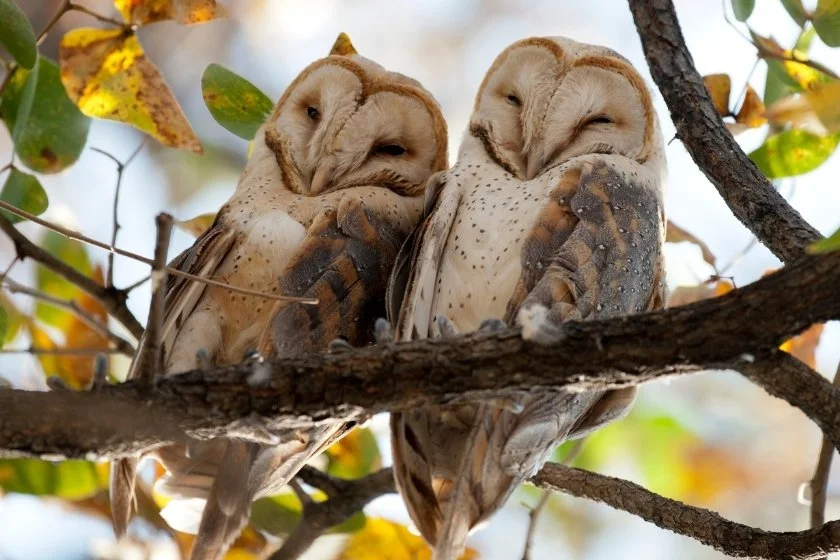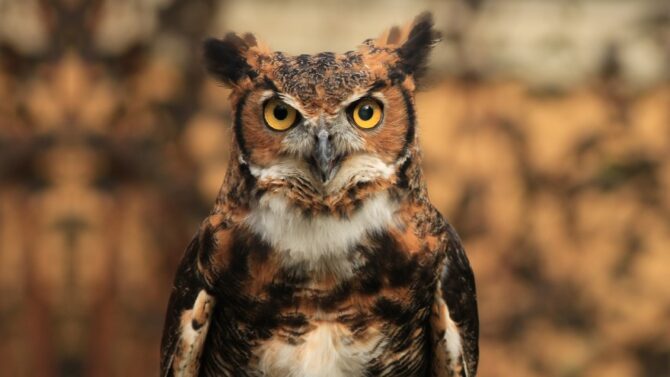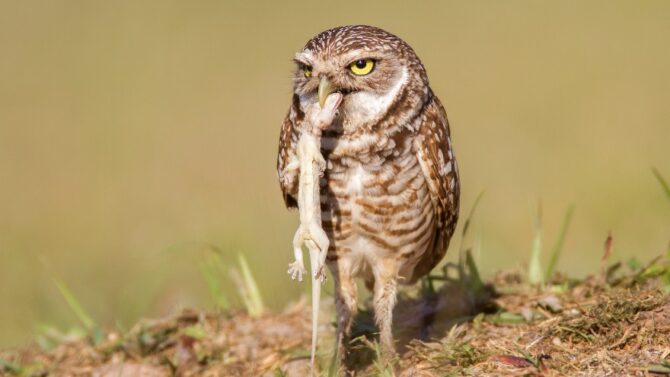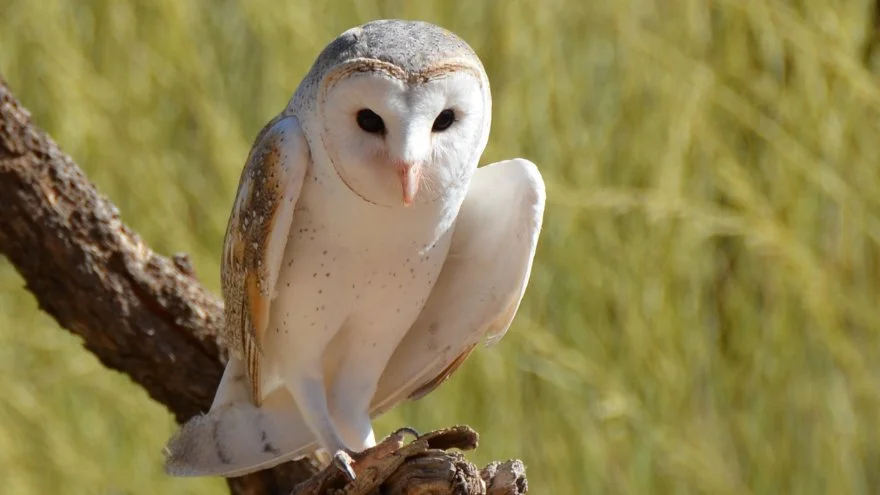Owls are magnificent birds of the Strigiformes order, all connected with peculiar traits. They are usually solitary and nocturnal, with large eyes that tend to glow at night.
There are many superstitions and myths surrounding these birds, causing some unneeded apprehension and even fear. However, these myths are unfounded.
There are over 200 species in existence today, spread all over the world.
These birds can be further classified into two families: the Strigidae (true owl) and the Tytonidae (barn owl).
Scientific Classification
| Kingdom | Animalia |
| Phylum | Chordata |
| Class | Aves |
| Clade | Telluraves |
| Order | Strigiformes |
| Family | Strigidae/Tytonidae |
Characteristics
| Height | 5 to 28 inches |
| Weight | 9 pounds |
| Venom/Poison | No |
| Skin Type | Feathers |
| Habitat | Grasslands, forests, swamps |
| Range | Worldwide |
| Diet | Carnivore |
| Life span | Up to 25 years |
| Gestation Period | 1 to 2 months |
| Conservation status | Least Concern |
5 Interesting Facts About Owls
1. They can rotate their heads up to 270 degrees!
Owls have very flexible necks, more than that humans. While it isn’t true that they can turn their heads a complete 360 degrees, they can get to a 270 degrees angle. Humans are limited to 180 degrees. This ability is important for owls because of their eyes.
Rather than eyeballs, these birds have eye tubes. There’s a structure in the skull called a sclerotic ring that holds the eyes in place.
Therefore, they can’t move their eyes. The neck enables them to see from different angles.
How are they able to turn their necks to that angle? The answer lies in the structure. The neck comes with 14 vertebrae, and they have alternative blood vessels that take blood to the head.
These alternatives help continue blood circulation when the neck is turned. Also, the vessels have casings that prevent them from rupturing.
2. They have special ears and wings
Owls use their ears when hunting, and these organs are assets, albeit weird ones. They aren’t placed in symmetry, and they are also of different sizes.
While this may seem odd to an observer, these traits are what make the ears special. Owls can get sounds at different times rather than just once.
With this ability, the hunter bird easily locates where the sound comes from and swoops down at the prey. The ears make for excellent hunting.
The other good hunting tool is the wings. Silent and broad, they enable our friends to glide through the skies without a sound.
The unsuspecting prey wouldn’t know what hits it. This is possible due to the feathers.1
3. Owls hoot (well, some of them)
Ask the average person what owls sound like, and you’re likely to get hooting as an answer.
While it is true that many species make the conventional hoo-hoo sound that slides into the night, not all species do this. In reality, they make a variety of sounds.
An example is the barn owl. Rather than hooting, they screech. Most people would consider the sound to be like that of a squeaking door when opened. Then there’s the barred owl, whose sound is more likened to a horse.
4. They are symbolic
These birds are both feared and revered, depending on the particular society and their culture. In some places, they are likened to sorcery and witches (think Harry Potter).
The Greeks and Romans of old had the belief that witches could take the form of owls and suck out the blood of babies.
Other folktales present them as signs of wisdom, and most owls you see in animated movies like Winnie the Pooh and Alice in Wonderland.
5. A group of owls is called a parliament
No one is quite sure why, but a group of owls is referred to as a parliament. This could be possible because of their reputation as wise animals.
Others suggest that the name was inspired by CS Lewis’ Chronicles of Narnia where the term was used to describe a meeting between owls.
Other terms used are congress and stare. The latter is less common.
General Description
Some identifying features unite all species. Every owl has a flat face with a sharp beak and immobile eyes.
The ears are usually asymmetric, while the wings are long, round and silent in flight. Then there’s the short tail, double toes facing forward, and those standing back.
The immobile eyes are that way because this bird is more of a predator than a prey. The eyes face forward so they can pick up prey from a distance. To look in different directions, the neck turns in 270 degrees.
As for size, color and shapes, there’s a lot of variety. It depends more on the particular species and individual quirks.
Common colors include gray, orange, black, white, and brown. The colors serve as camouflage in many cases, blending well with the environment.
In size, there’s a wide spectrum. The smallest species is the elf owl which measures up to 6 inches, and the biggest is the Blakiston’s fish owl which gets to 2 feet.
The feathers are all soft and dense regardless of species. You could easily see them hanging out. This plumage enables silent flight and protects from extreme cold.
Distribution and Habitat
Owls can be found all over the world except in Antarctica. The different species of owls are in Asia, Africa, Europe, Oceania, and the Americas. The probability is high of you seeing this creature at least once.
These animals love to stay above the ground, though some species build nests on the ground. Most love to remain on cliffs, tree cavities, and woodpecker holes.
Their habitat varies as much as the species, but there are some common places they inhabit. Examples are grasslands, forests, tundras, woodlands, etc.
Diet
As birds of prey, the owl is a carnivore and an excellent hunter. It does most of its hunting at night, relying on its sight, hearing, and quiet wings.
Its diet is relative to size and species. Common prey includes rodents, insects, and snakes. Some species also feed on fish.
This bird’s main method is similar to other birds of prey (like eagles and hawks). It locates the prey from above and swoops down to grab it.
While they are not the fastest birds, they have speed. They can reach a flight speed of around 40 miles per hour, taking any prey by surprise.
Not all individuals take the flight-and-grab approach, though. Some species perch and pursue the prey.
Reproduction and Mating Process
Owls are known to be monogamous, but this isn’t an absolute rule. A male and a female would often form a small family unit, and they don’t easily change partners.
The bond usually lasts for a lifetime. However, a couple can separate if they’re unable to give birth.
The male takes initiative in the courtship process. He may bring gifts or perform a complex dance process to draw the female closer.
Most females tend to be wary of males, and only when comfortable would they draw close. Once she’s comfortable, the couple mates.
Couples build nests together, and they often maintain them for a long time. Materials used to construct the nest include leaves, grass, fur, and feathers.
The nesting period depends on the species and location. For instance, those in the Northern parts nest in the spring.
The gestation period goes up to 2 months, after which the female lays eggs. She usually doesn’t lay at the same time, but a couple of days apart for each.
Some eggs can get up to 12, but there’s no uniform expectation. The little ones are called owlets or fledglings.
It is survival of the fittest, and usually, the first ones to be hatched gain an advantage. If there isn’t enough food, the last owlet may be left to starve.
Owlets usually get their full feathers after some months of hatching. They gain their full independence right after getting the feathers.
Predators and Threats
Being ferocious predators, they have only a few predators of their own. Owls might only be threatened by other birds of prey or predators like wildcats, skunks, weasels, squirrels, and other owls.
The smaller the species, the more likely it is to be eaten. Young and weak individuals are also more vulnerable than healthy adults.
These creatures also come under attack from humans, especially in regions where they are perceived as ill luck or a symbol of witchcraft.
The unfortunate result is the population decline of some species. Owls face motor collisions, deliberate poisoning, and hunting. They also suffer from habitat loss.
Behavior
These birds are solitary, only forming a small family unit when they need to mate. This unit consists of just a male and a female.
Though solitary, sometimes they form large flocks when there’s a need for protection and safety. This flock is what people refer to as a parliament, stare, or congress.
They produce more sounds than people give them credit for, far more than hooting. These include screeching, clapping wings, snapping beaks, and body postures meant for mating.
Some species hiss, neigh like horses, and even behave like rattlesnakes. Their sounds can be classified as songs.
Male vs Female

Determining the sex of an owl can be difficult, and sometimes you’ll need the help of an expert to do so.
The differences aren’t overt, and from a casual standpoint, they look the same. There are some distinctive factors, however.
Females tend to be bigger than males in size and wingspan. Amongst barn owls, the female also has some different colors. Her legs are darker, and the beak is colored buff compared to the ivory of the male.
Frequently Asked Questions
Are owls good pets?
Birds of prey don’t make good pets, that includes the owl. While they can be kept in captivity and taken care of, they are at heart wild animals. You need a lot of experience to handle one.
What do owls symbolize?
In some cultures, owls have a bad image. They are often associated with witchcraft and are considered bad luck. In other places, this bird stands for wisdom.
Are owls intelligent?
Despite their reputation as wise creatures, owls are not very smart when considered with other birds. They do not show any remarkable feat of intelligence, but they have many capabilities nonetheless.
Final Thoughts
The owl may be scary to some people, but the idea of it being bad luck is a myth. These birds are like any other bird of prey you can think of, including eagles and hawks.
They live solitary lives (mostly), hunt at night (also mostly), and have many other features that people don’t know about.
Though it looked cool for characters in Harry Potter to own owls, these birds don’t make good pets, unless you plan on going to Hogwarts.
References & Notes
- Wagner H., Weger M. (2017). Features of owl wings that promote silent flight. Interface Focus.



